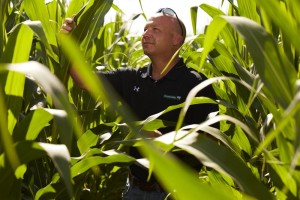The Need For Nutrients
The appetite for high-yielding technology has never been higher. With adoption of those technologies comes ancillary effects we’ve never had to consider. Such is the case with triple-stacked hybrids.
Industry experts estimate that more than 50% of U.S. corn acres were planted in stacked-trait, insect-resistant hybrids in 2013. It’s an important time to remember: There’s no easy option for long-term yield gain.
“As yields increase, so does the amount of nutrients we’re taking out of the soil,” says Gary Spence of Crystal Valley Coop, Lake Crystal, MN. “It’s important that growers pay close attention, because the game is changing in terms of nutrient removal. We’re finding that levels have dropped in a lot of fields in our areas and that means we need to pay closer attention to the soil.”
It’s important for retailers to remind customers that maximizing the benefits from top seed technology requires a comprehensive crop management approach. This includes assessment of nutrient uptake and the exact nutrition prescription needed to help the hybrid achieve success.
The Corn Rootworm Problem. There’s perhaps no better example than the plight of Corn Belt growers fighting corn rootworm. Corn rootworm is one of the most devastating insect pests corn growers face each year. It does its greatest damage at the larval stage, feeding on the roots of young corn plants. Rootworm larva feeding inhibits the corn plant’s ability to take up water and nutrients, including potassium, decreasing plants’ ability to grow, which can ultimately lead to yield loss.
More Tech, More Nutrient Uptake. Research conducted at the University of Illinois suggests that micromanaging the crop’s nutritional needs is critical in pushing the yield barrier and maximizing return on investment.
University of Illinois Professor of Plant Physiology Dr. Fred Below compared corn rootworm-resistant hybrids with their conventional counterparts to examine the variance in nutrient uptake.
Dr. Below confirmed the new resistant hybrids take up more nutrients than conventional counterparts, and that the increase in potassium uptake was greater than the increased uptake of many other nutrients.
This underscores the need for growers to combine a strong fertility program and balanced crop nutrition with the high-tech seed they’ve selected, in order for that seed to reach its full potential.
Maintaining The Power of Potassium
Potassium (K) is a vital nutrient to plant growth, since it performs a number of core functions to ensure healthy, stress-resistant plants. Treat plants to enough K, and the damage that pests and tough conditions create will actually be inhibited.
When water is scarce, K helps create concentration gradients inside the plant to help pull water into the plant. Furthermore, K regulates leaf tissue openings (stomata), helping them open and close quicker, which reduces moisture loss through the leaves and helps keep moisture in the plant.
Aside from helping maintain stalk strength and standability, K helps prevent disease by ensuring sugars and proteins the plant produces do not build up in tissues. Tissues with high levels of sugars and proteins attract insects and disease because these sugars are such excellent food sources for the pests. Adequate K levels in plants help maintain lower concentrations of sugars and proteins in cells, helping to prevent disease infections and deter insects.
On the other hand, K deficiencies can create a vicious cycle of unmet needs for a corn crop under pressure. Stressful conditions, such as those created by drought, disease and insect pressure, can interfere with root development as well as access to soil K and other nutrients.
Since corn rootworm-resistant hybrids require more K, it’s of increased importance that growers have a plan in place to protect the supply of this key nutrient pivotal to yield success.
It’s becoming clear across the Corn Belt that some growers are removing more K from the ground than they’re putting back.
“We’ve seen an increased demand for potash in our area, where the fertilizer needs seem to be on the rise,” says Spence. “It used to be that you could hold back based on rotation, but now we’re seeing a lot of farms spreading on every acre, every year.”
The International Plant Nutrition Institute’s most recent study of soil fertility levels showed that in many regions, K levels are declining, a strong indicator that growers’ current fertilization rates are not adequately replacing nutrient removal by high-yielding hybrids.
High-performance seed technology is a big investment for growers, and a proven tool for boosting yield. Hybrid seeds are an outstanding tool for higher yield, but not a replacement for the nutrients that allow the corn plant to prosper. It’s important to help producers take into account what this technology is removing from the ground as well.
As growers around the country strive toward next-level yields from high-producing hybrids, it’s more and more likely they’ll be looking for advice on updating their nutrient management plans as well. Helping growers revise fertility plans to take into account new requirements for K will be critical to help achieve unprecedented yields.






